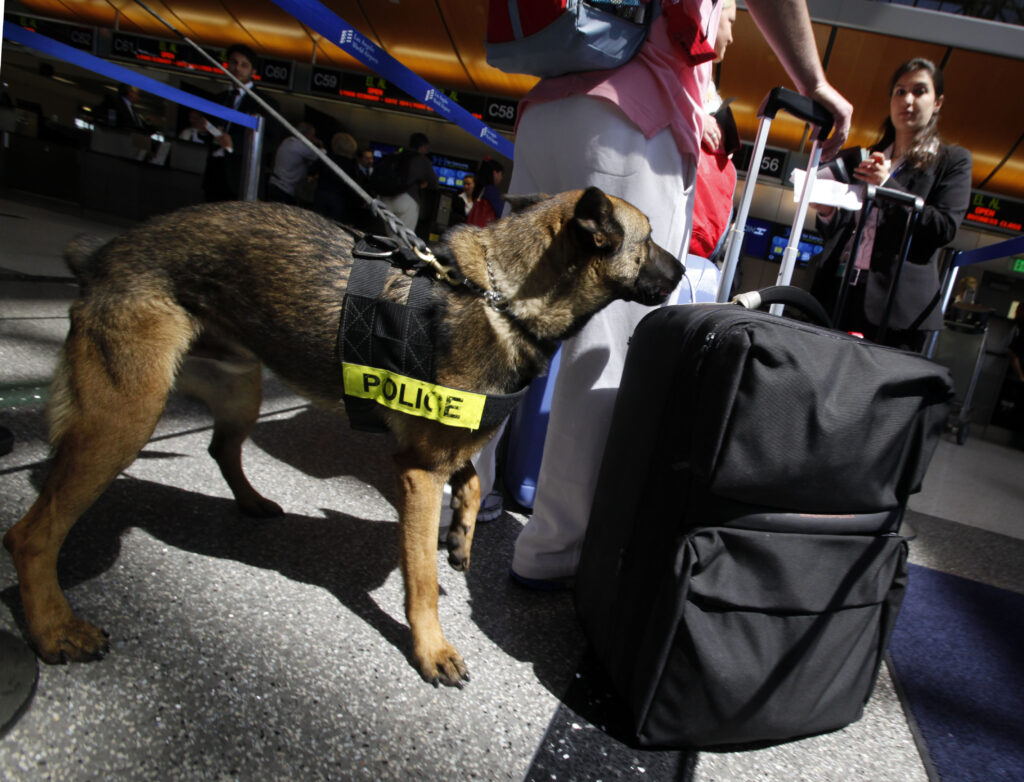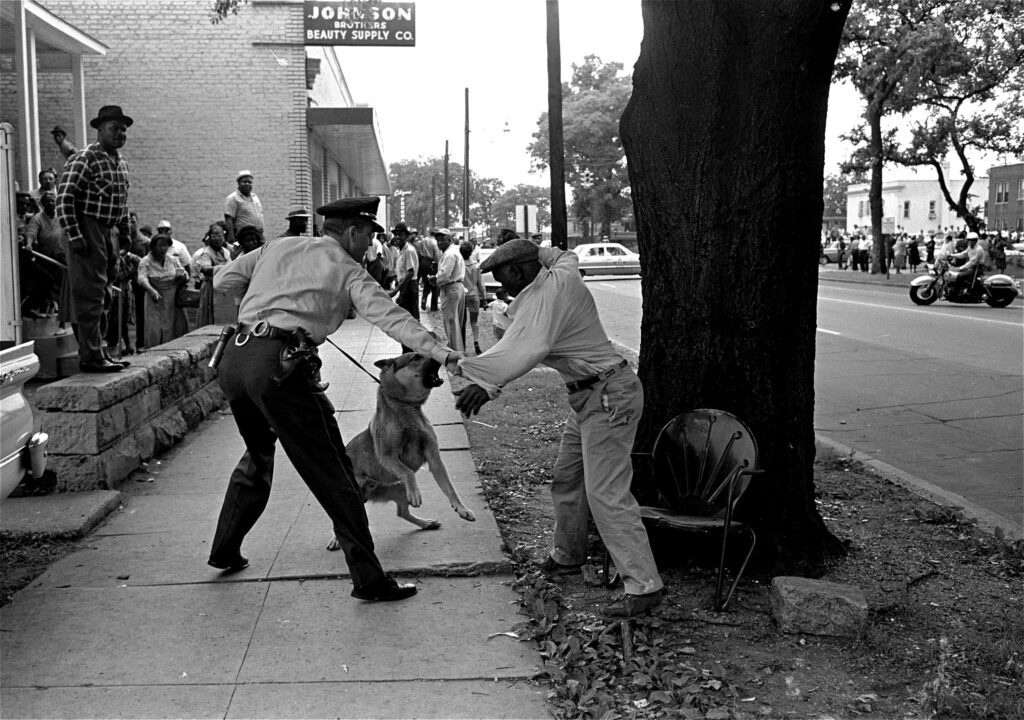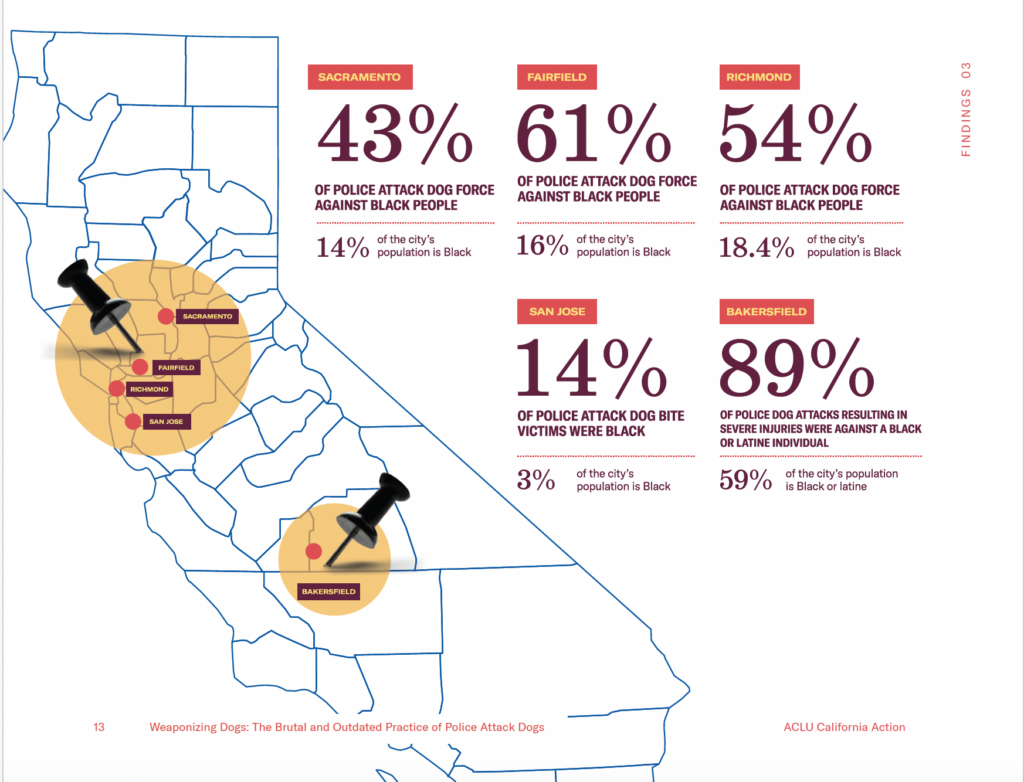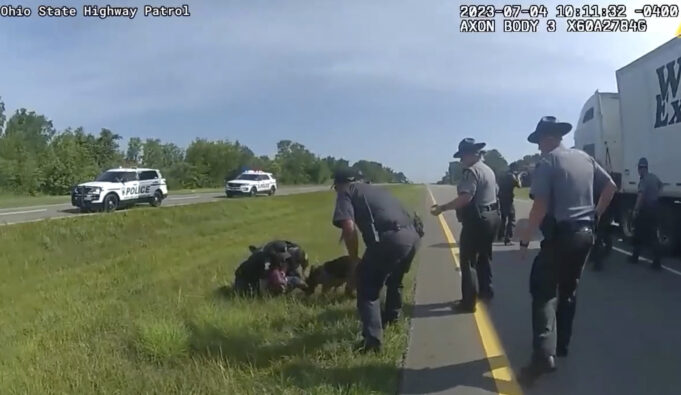A recent report by the American Civil Liberties Union (ACLU) found that police attack dogs have severely and permanently injured hundreds of Californians, particularly Black people, although they posed no threat to officers.
“Weaponizing Dogs: The Brutal and Outdated Practice of Police Attack Dogs” found that statewide, two-thirds of Californians severely injured by police dogs were non-White; Black Californians are 2.6 times more likely to be seriously injured by police attack dogs than White people; and national use of force data also shows that police most frequently use attack dogs to bite Black boys and men.

“We’ve seen dogs used against Black folks as far back as the ‘60s. I can remember as a small child seeing those images on television with the police attacking peaceful protesters with the use of a canine,” stated Cheryl Ford Dorsey, retired LAPD sergeant and author of “Black & Blue (the Creation of a Manifesto): The True Story of an African-American Woman on the LAPD and the Powerful Secrets She Uncovered.”
“Unless and until the community gets involved and gets engaged, we’re going to continue to have these problems. Police departments, I believe, have a special little slush fund set aside … (she chuckled), so when something like this happens, it makes national news, they’re prepared and willing to just pay a fine, settle with the family, get a nondisclosure agreement as to what that settlement really looks like, and then it’s just business as usual,” Ms. Dorsey told The Final Call.
According to the report, released in January, this pattern of racialized violence can be observed locally, as well. In Sacramento, police directed 43 percent of police attack dog force against Black people, who make up only 14 percent of the city’s population, it found.
And similarly, according to Census and use of force data across the Bay Area, police disproportionately use attack dogs against Black residents. The report revealed:
• In San Jose, 14 percent of police attack dog bite victims were Black, though Black residents are three percent of the city’s population.
• In Richmond, over a five-year period, over 54 percent of people bitten by police attack dogs were Black, in a city that is 18.4 percent Black.
• In Fairfield, in the same time period, over 61 percent of people bitten by police attack dogs were Black, in a city whose population is 16 percent Black.
• In Bakersfield, in 2020, 89 percent of police dog attacks resulting in severe injuries were against a Black or Latino individual, though Black and Latino residents collectively make up 59 percent of the city’s population.
• Bakersfield Police Department’s racialized use of police attack dogs is also evidenced by the fact that its officers’ use of attack dogs is clustered in its communities that are predominantly Black and Latino.
The language and symbolism used by the police agency who deploy the dogs also demonstrates the radicalized use of the canines, according to the report. It indicates that public records document:
• A San Diego Police Department handler joking that his dog “only likes dark meat.”
• A police dog training facility that trains and supplies police attack dogs to many California police agencies, including the Los Angeles Police Department, shares its name—Adlerhorst—with a Nazi command post and bunker used by Adolf Hitler. And text messages obtained by federal investigators show an Antioch handler making derogatory and racist comments as he sent other officers’ trophy photos he collected of injuries inflicted by his attack dog.
• As the California Reparations Task Force report recounts: “Slave patrols … used dogs to attack enslaved people by biting them but also to instill fear, and used bloodhounds to track down enslaved people. Much like slave patrols, police have continued to use dogs against African Americans in the 20th century through the present. Police used dogs against demonstrators during the civil rights movement.
The United States Department of Justice noted in its 2015 report that the Ferguson Police Department “exclusively set their dogs against Black individuals, often in cases where doing so was not justified by the danger presented.” In Baton Rouge, Louisiana, police dogs bit at least 146 people from 2017 to 2019 and almost all of whom were Black …, the report highlighted.
According to the report, the California Reparations Task Force also states:
• In the 1980s, the Los Angeles Police Department, which is the largest police department in California and one of the largest in the country, referred to African American suspects as “dog biscuits.”
• Victims of police dogs sued and alleged that the department disproportionately used dogs in minority neighborhoods, which resulted in police dogs inflicting 90 percent of their reported bites on African Americans or Latinos.
• In 2013, the Special Counsel to the Los Angeles County Sheriff’s Department, which is the largest sheriff’s department in California and the country, found that African Americans and Latinos comprised 89 percent of the total individuals who were bitten by the department’s dogs from 2004 to 2012. During the same time, the Special Counsel found that the number of African Americans that police dogs bit increased 33 percent.
The report is based on analysis of official data, policies and public records obtained from 37 police agencies across California. The report also found that police are using attack dogs specifically to bite and threaten people experiencing a behavioral health crisis. In several cases, police were unable to control their attack dogs, who regularly mauled bystanders and failed to stop attacking when recalled, according to the report.
“My brother David was in medical distress and sought medical help, but instead the sheriffs deployed their police dog to bite him several times,” said Chris Silva, brother of David Silva, who was killed in May 2013, after Kern County Sheriff’s deputies released a police attack dog on him before beating and hogtying him, reads an ACLU press release, dated Jan. 10.

“The unanswered questions linger—why, when David was experiencing pain or trauma, were the police called to respond instead of someone with health expertise and why did the deputy release a police dog to attack David who was deep asleep?” Chris Silva added.
“The vast majority of Californians severely injured by police attack dogs are not armed with any weapon, according to data reported by police agencies to the CA Department of Justice,” said Carmen-Nicole Cox, director of government affairs at ACLU California Action. “The state of California must act with urgency to protect the public and enact legislation addressing police agencies’ use of attack dogs,” continued Ms. Cox.
The ACLU is calling for support for Assembly Bill 742 which will restrict the practice of using police canines by creating statewide standards in California. AB 742’s primary author is Assemblymember Corey Jackson (D-Riverside). It is co-sponsored by ACLU California Action, the NAACP California Hawaii State Conference, and Families United 4 Justice.
In addition, “Weaponizing Dogs” found that state law and police policies fail to prevent police attack dogs from unnecessarily inflicting violence against the public or provide accountability when individuals are harmed by their indiscriminate and unnecessary use, and, while law and police agency policy recognize weapons like batons or tasers as serious instruments of force, more Californians suffered life-threatening or life-altering injuries resulting from police dog attacks than those similarly harmed by batons or tasers.
According to Altaf Saadi, MD, a neurologist at Massachusetts General Hospital, Assistant Professor of Neurology at Harvard Medical School, and PHR medical expert who co-authored the report’s expert opinion, “Californians have suffered extreme physical and psychological harms from the unleashed brutality of police attack dogs,” indicates the ACLU’s Jan. 10 release.
“The bites from police attack dogs—which are disproportionately weaponized against Black Californians—cause deep and lasting wounds that often result in long-term pain and permanent disability, including nerve injury, loss of function of arms and legs, disfigurement, and enduring psychological trauma,” the release continued.
“Given the scale of this problem and the findings set out in this brief, the state of California must act with urgency to protect the public and enact legislation addressing police agencies’ use of attack dogs,” wrote the report’s authors.

“It’s just more of the same. It’s what we’ve been witnessing with overzealous officers who act with impunity because they probably suspect that they’re going to have the backing and support of command staff at their agencies and so police dogs are not different than a group of police officers attacking someone unnecessarily,” Ms. Dorsey stated.
Cardia X is a full-time certified police officer in the State of Illinois with nearly a decade of experience. He has worked with police dogs for both locating and apprehending offenders. “I will say I am in no way surprised that the majority of the victims are Black. We tend to lead in every negative outcome, especially in law enforcement,” he told The Final Call.
He thinks legislation restricting or regulating the use of police dogs is good for advocates who desire to do so. But in honesty, he said he’s seen both the positive and negative side of using police dogs for apprehension.
“In my experience, I have only requested the use of a dog to apprehend a fleeing or barricaded offender who is wanted for a violent felony offense. However, I also want us to be mindful that changing a law means nothing if the mindset that causes the behavior that the law seeks to correct is not dealt with. The White man is the master of giving you a law today and then enacting policy to nullify the law tomorrow,” stated Ofc. Cardia X.
“I would call us to what the Most Honorable Elijah Muhammad called us to in a 1968 article of Muhammad Speaks entitled, ‘The Black Policeman And What He Polices, Part 1.’ The Most Honorable Elijah Muhammad closed the article by saying, ‘Throughout the country, let us take over where we are dominant in towns and cities and have Black officers in control of enforcing the law upon us.’ This is the best and only true police reform for the Black community.”













